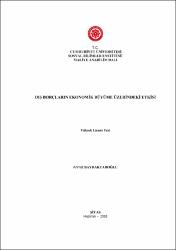| dc.contributor.advisor | Adıgüzel, Uğur | |
| dc.contributor.author | Bayraktaroğlu, Ahmet | |
| dc.date.accessioned | 2020-01-08T13:15:10Z | |
| dc.date.available | 2020-01-08T13:15:10Z | |
| dc.date.issued | 2018 | tr |
| dc.date.submitted | 2018-06-21 | |
| dc.identifier.other | V, 99 sayfa | |
| dc.identifier.uri | https://hdl.handle.net/20.500.12418/12067 | |
| dc.description.abstract | Dış borçlanma, bir ekonomi içerisinde yapılan tasarrufların yetersiz olması durumunda başvurulan bir yöntemdir. Bu yöntem özellikle Türkiye gibi gelişmekte olan ekonomilerin kalkınma süreçleri için de önemli bir finansman kaynağıdır.
Türkiye ekonomisi incelendiğinde 1980’li yıllardan itibaren dış borç önemli bir problem haline gelmiştir. 24 Ocak kararları ile birlikte ithal ikameci sanayileşme politikası terkedilmiş, ihracata dayalı büyüme stratejisine geçilmiştir. Bu yapısal değişim ile birlikte ihracat, ithalat ve sermaye hareketlerinde artış yaşanmıştır. Tüm bu gelişmeler Türkiye ekonomisinin dış borcunun da belirgin bir şekilde artmasına neden olmuştur.
Borçlanmanın temelinde gerek kamunun yatırımların finansmanında sermaye ihtiyacını karşılama isteği gerekse özel sektör yatırımların finansmanında finansal sektörün yabancı sermaye kaynaklarını kullanması bulunmaktadır. Geçen süreçte dış borcun kompozisyonu değişse de ekonomide artan bir dış borç stoku bulunmaktadır.
Bu çalışmada, dış borçlanma kavramsal ve teorik olarak açıklanmakta, nedenleri ve sonuçları betimlenmektedir. Daha sonra tarihsel süreçte Türkiye ekonomisinde dış borcun gelişimi dönemler itibariyle anlatılmıştır. Üçüncü bölümde konu ile ilgili literatür taranmış ve özetlenmiştir. Son bölümde ise değişkenlere ait veriler temin edilmiş ve ampirik analiz, zaman serisi metotları kullanılarak yapılmış ve sonuçlar ışığında politika çıkarsama yapılmıştır. | tr |
| dc.description.abstract | External borrowing is a method that is used when savings in an economy are
inadequate. This method is also particularly important source of financing for
development process of emerging economies such as Turkey.
Considering Turkey's economy has become a major problem external debt
since the 1980s. With the decisions of January 24th, the import-substitution
industrialization policy was abandoned and the export-based growth strategy was
started to employ. With this structural change, exports, imports and capital movements
increased. In the light of all these developments, the external debt of Turkey's
economy has resulted in a significant way to increase.
At the core of the debt is the need for the capital to finance the investment of
the capital and to use the foreign capital resources of the financial sector for the
financing of the private sector investments. Although the composition of foreign
borrowing has changed in the past, there is an increasing foreign debt stock in the
economy.
In this study, external borrowing is explained conceptually and theoretically, its
reasons and results are described. Then, development period of external debt in the
historical chronology has been described in Turkey's economy. In the third chapter,
literature related to the subject has been scanned and summarized. In the last part, the
series belonging to the variables were obtained and empirical analysis was made using
time series methods and the policy implications was made in the light of the results. | tr |
| dc.language.iso | tur | tr |
| dc.publisher | Sivas Cumhuriyet Üniversitesi- Sosyal Bilimler Enstitüsü | tr |
| dc.rights | info:eu-repo/semantics/openAccess | tr |
| dc.subject | Dış borç | tr |
| dc.subject | Türkiye Ekonomisi | tr |
| dc.subject | Ekonomik büyüme | tr |
| dc.subject | Zaman serisi analizi | tr |
| dc.title | Dış Borçların Ekonomik Büyüme Üzerindeki Etkisi | tr |
| dc.type | masterThesis | tr |
| dc.contributor.department | Sosyal Bilimler Enstitüsü | tr |
| dc.relation.publicationcategory | Tez | tr |















